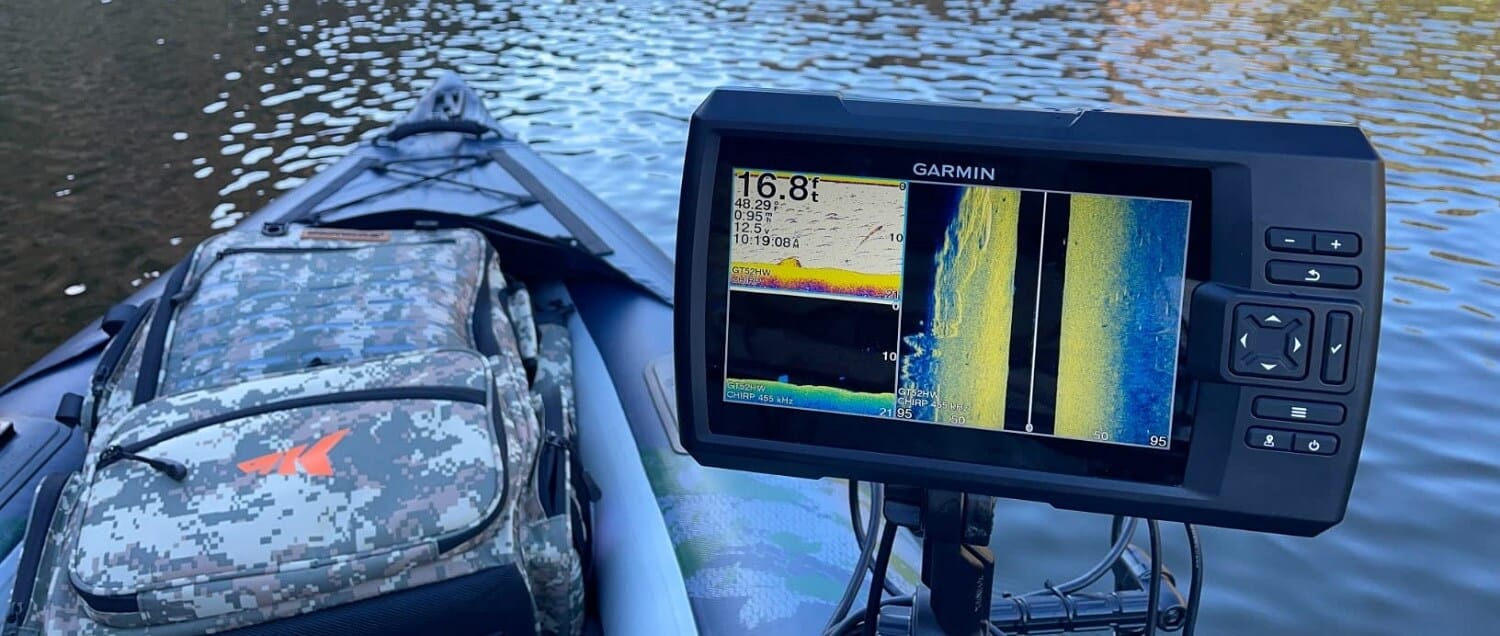Determining the optimal spot to cast your line in a lake can be made significantly easier with the use of a fish finder. Nowadays, advancements in sonar technology, GPS integration, and user interface design have enhanced the accessibility and user-friendliness of fish finders more than ever before.
Navigating the array of fish finders available to meet diverse needs can be challenging, making it difficult to pinpoint the most suitable option within a budget of $200.
Whether you’re fishing from a kayak, canoe, or ice fisherman, you’ll find the best fish finders under $200 on this list for your needs. Our team has researched and assessed various options on the market to highlight top contenders offering dependable performance, intuitive interfaces, and advanced features, all within the $200 price bracket.
Best Fish Finders Under $200 Reviews 2025
Let’s see our ranking of the best fish finders under $200 at a glance…
- Garmin Striker Vivid 4cv Fish finder – Our Top Pick
- LUCKY YT-US-Y2020-CLA – Best Wireless Handheld Fish Finders
- Aukfa 001254 Underwater – Best Underwater Fishing Camera Under $200
- Garmin Striker 010-02246-02 Sonar with GPS – Editor’s Choice
- LUCKY FF718LiC-W Fish Finder – Best Value for the Money
1. Garmin 010-02550-00 Striker Vivid 4cv – Top Pick
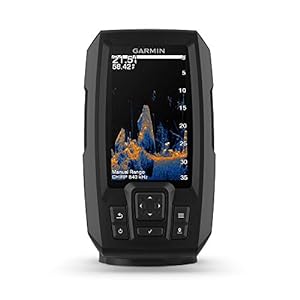
The Garmin Striker Vivid 4cv fish finder emerges as the test winner on several review portals, thanks to its excellent value for money and various extra features. We highly recommend this model to any kayak angler seeking a fish finder with great value. It doesn’t occupy much space, making it a practical choice.
Besides the dual-beam with frequencies of 77 kHz and 200 kHz, the Striker 4cv works with 455 kHz and 800 kHz to enable accurate representation of the soil structure. Garmin Striker Vivid 4cv fish finder has a lasher feature like the Garmin Striker 4 Plus.
It has 7 color options to see fish and structure in maximum contrast and clarity. Its different color schemes can also be independently set up. The screen is easy to remove from the mount bracket for storage. The package includes a tilt/swivel mount plus transom and trolling motor mounting hardware and cable.
You can make a plan or create routes to view your boat speed on your fish finder by using a high-sensitivity GPS. With this model, you can store up to 2 million acres of maps with 1’ contours.
The transducer is a streamlined design to be mounted to a kayak or boat. However, it can be dropping down an ice hole. There is a special ice fishing display view. It is easy to install and use.
With Garmin Striker Vivid 4cv fish finder, you can find whole schools of fish that will cap off the day of fishing with success. However, the side imaging is functional and shows you fish and large features, but not Crystal clear. If this is not a big issue to you, you won’t go wrong with this fish finder.
PROS
- Water-resistant
- Easy-to-use color display
- Built-in high sensitive GPS
- It be can set to alarm at a set depth
- Display is available in 4 different sizes
- Easy to set up and navigate
CONS
- No touchscreen option
- Does not come with a cover for the screen
- There is no instruction
- SD card slot isn’t available
2. LUCKY YT-US-Y2020-CLA Wireless Handheld Fish Finder
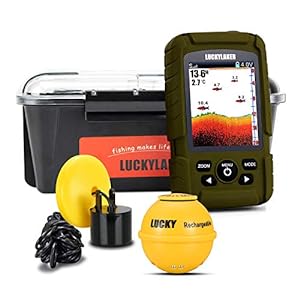
This wireless fish finder from Lucky can localize the fish up to a depth, measure the water depth and the water depth, and recognize the bottom contour. It has a range of 100 meters. This model has a simple design with a 7.1 cm LCD display. The sonar transducer works with 125Khz in a 90-degree beam angle.
You can throw this device very well into the water from the bank. Then it shows the depth of the water and any fish echoes. It can be used in both salt water and fresh water. Another advantage is the ease of use; this device only has to be switched on and is then ready to use.
It is waterproof in rain, no need to worry about the splashes. Even if it drops into the river or lake, it will float on the water. It can be worked for 5-6 hours after completing the charge. You just need to set it in the open air to avoid water vapor because of the temperature differences.
You can easily be concerned about the water depth. If you attach the transducer to the hull of your boat or kayak, you can identify the water depth distribution of a specific area when your boat or kayak is moving. This means you can understand the approximate fish location and fish size by the display.
LUCKY wireless handheld fish finder supports up to 328ft wireless operation and max 147ft water depth detection for wireless mode. And the depth detection range can reach up to 328ft when you switch to wired mode. You can switch from wired mode to wireless mode, depending on the different fishing environments.
The package also comes with a 25ft/7.62m extension cable and an anti-fish bite plastic float.
Package Content:
PROS
- Waterproof display
- Both wired and wireless design
- Anti-corrosion material
- Durable and user friendly
- Great fish finder under $200 for kayak fishing
CONS
- Only 90° offers a wide detection area
3. Aukfa 001254 Portable Underwater Fishing Camera
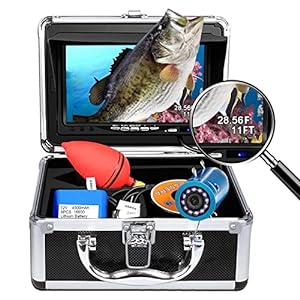
Whether you’re a beginner, or already fishing at a professional level, you can extend your fishing experience to the next level with the Aukfa portable underwater fishing camera. Although it won’t cover all the points a stationary fish finder offers, this underwater camera lets you know what’s happening under the surface.
It features a 7-inch LCD screen with an HD definition that provides crisp and clear images. Also, the LCD monitor features a removable sun visor, so you can use it when going fishing on sunny days in the sea or lake. You can easily identify the depth and temperature of the water through the screen.
This device is equipped with 12 pcs IR LED lights that you can turn on or off, which allow you to 130° viewing so that you can see the fish in dark environments or murky waters, and shoot an HD quality video in the dark. Also, it is fully waterproof. To ensure safe transportation, this model comes with a durable carrying case.
Aukfa underwater fishing camera with fish finder includes a powerful 12V 4500 mAh battery that gives you up to 8 hours of service when fully charged! The package includes an 8GB SD card, so you can record the underwater landscapes to take photos and videos of the wonderful moments when fishing.
Package Content:
PROS
- Good battery life
- Convenient to use
- Large and depth temp display
- HD camera with IP68 waterproof
- Perfect for all types of fishing
- Large cord length
CONS
- No wireless function
- Useless instruction paper
4. Garmin Striker 010-02246-02 Castable Sonar with GPS
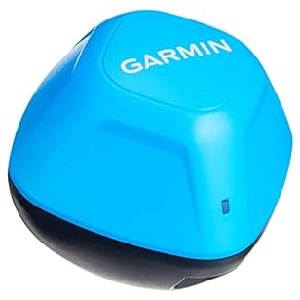
Garmin castable sonar device works with free striker cast app and is compatible with Apple or Android devices. It is a wireless stream sonar that locates the fish and displays them on your smartphone or tablet in seconds. Just download the app, connect your device, and then start fishing in minutes.
It is built with GPS feature that let you create your own custom fishing maps with 1’ contours. The traditional 2-D and ice fishing flasher sonar modes stream wirelessly from up to 200’ away with the striker cast app on your mobile device. It performs well in both shallow and deep water. It will show water depth, fish depths, and fish size.
The battery life is incredible, which provides 10 plus hours of service after being fully charged. To conserve battery life, it will automatically power on when it’s floating in the water and turn off when it’s not.
For added simplicity in using this device, activate the fish icons feature to display graphic images of fish targets along with their depth readings, providing precise guidance on where to drop your line. You can also utilize the Garmin Quickdraw community to download maps and engage with fellow users.
The Garmin Striker Castable Sonar is water-resistant, meeting IPX6 and IPX7 standards. However, it is not fully waterproof and should not be submerged beyond 1 meter for more than 30 minutes.
It works in any water even for ice fishing to show you fish and structures in crisp detail. You can use this device to check water temperature as well. If you’re looking for an affordable sonar to use ice fishing, we highly recommend this model.
PROS
- Surprisingly small, but quite capable
- Quick and easy to set up
- Works great on any water
- Durable and easy to cast
- Built-in GPS
- Lightweight
CONS
- It will get some interference from the sides of drill holes unless you use a larger hole and find a way to keep the device in the center of the hole.
5. LUCKY FF718LiC-W Portable Fish Finder
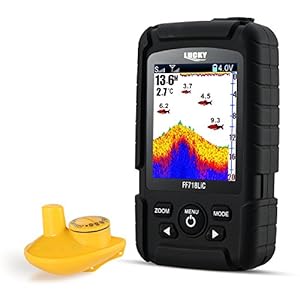
The LUCKY FF718LiC-W fish finder accurately determines water depth and provides approximate fish location, while also detecting weeds, sand, and stones on the bottom. Its versatility makes it suitable for various fishing environments, including ice fishing, sea fishing, and deep-sea fishing.
This portable fish finder performs exceptionally well in depths of up to 100 meters and is suitable for all types of water bodies, providing detailed analysis. Furthermore, users have the convenience of specifying measurements in feet. Other valuable features include a battery-saving mode, fish alarm, and backlight.
The sensitivity is highly adjustable, allowing you to customize fish icons, alarms, and select from three color display options. Despite its simplicity, it possesses the power to deliver accurate and reliable readings consistently.
This unit can display the shape of the lake bottom and structures, such as holes and drop-offs. So, if you are looking for a cost-effective fish finder that has high-depth capability, then the FF718LiC-W should be your priority. The manufacturer also offers 1 year guarantee.
This model earns its place in our ranking because of its convenient size and adaptable mounting system, making it versatile for placement on various vessels such as kayaks, canoes, or even ice setups. Its performance remains impressive even in challenging conditions such as high waves.
It’s important to note that this device does not come with a power adapter; however, the package includes a USB cable for charging. You can conveniently charge it using the USB cable through a computer or other smart devices. Also, the topographical mapping isn’t good enough to get you on the edges.
PROS
- Good price with high quality
- Easy to use and compact
- Nice color display
- Wired and wireless mode
- Floating design
CONS
- Small display
Best Fish Finders Under $200 Buying Guide

When purchasing a fish finder under $200, it’s essential to consider several key factors that can make it an invaluable tool for any fisherman. Let’s delve into these points in more detail.
Frequency range
Frequency range should be chosen depending primarily on where the angler is fishing and what needs the angler has. For example, if you want to find certain predatory fish mainly in local lakes and rivers, you can only use a fish finder with a single beam. But if you are looking for cod, flatfish, or sea salmon in deep waters, you require a fish finder that extends in width but above all in-depth.
A fish finder with a high-frequency range emits shorter waves into the water. Ideally, these waves bounce off obstacles and are then detected and analyzed by the device. The angler can then view the results on the display, providing information about the location of fish, water depth, temperature, and even details about the bottom composition.
Moreover, longer wavelengths typically yield better imaging. For instance, a fish finder offering 200 kHz not only delivers precise data but also reveals whether the bottom terrain is flat or rocky.
Transmission power
Another important purchase criterion when buying the best fish finders under $200 is transmission power. Here anglers can use a simple rule of thumb as a guide. The higher the transmission power (in watts), the more details are shown on the display. Very good models have values between 500 and 4,500 watts.
Clearer images greatly enhance your chances of making successful catches, especially when fishing in murky waters. In such conditions, lower-quality models may struggle to distinguish between fish and other objects, such as plant debris. Therefore, opting for a fish finder with higher transmission power is advisable to ensure optimal performance and accurate detection.
Display and presentation
Most fish finders have LCD displays. Nevertheless, there are sometimes quite big differences. To be able to see images very precisely, the monitor should have the highest possible resolution and good contrast. Sun protection is also an advantage to read all the information without any problems on very sunny days.
Black and white displays should have a large number of so-called gray levels. Display that works in grayscale is very helpful, as the contrasts are even better visible.
Stationary or mobile
There are stationary and mobile fish finders available today.
Stationary fish finders are attached directly to a boat. It emits ultrasound waves to the water from its underside and delivers good results. After all, it is located directly above the water with less interference.
A mobile fish finder, on the other hand, is useful for anglers who don’t have a boat. The difference is that such a device sends ultrasonic waves over the water. So you still have to bridge a little bit of air and sometimes deliver somewhat poorer images. Some good mobile fish finders deliver excellent results and do not hide behind stationary versions.
Side imaging
Many top fish finders under $200 come with a highly practical feature known as side imaging. This technology allows the device to not only scan downwards but also to capture images of the area to its left and right. Consequently, the fish finder provides detailed imagery across a wide viewing angle.
However, the results of such a device are a little harder to read. The angler should therefore already have some experience if he wants to use such a fish finder.
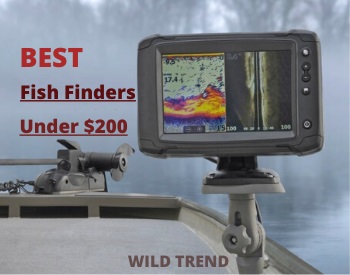
FAQs
Can I use a cheap fish finder in saltwater?
Yes, many budget-friendly fish finders are suitable for both freshwater and saltwater use. However, you should rinse the equipment with fresh water after using it in saltwater to prevent corrosion.
Are apps better than separate devices?
It depends on consumer demands. While stationary echo sounders work precisely, the apps that only use GPS are very imprecise. However, some manufacturers combine different technologies and offer reliable app-based fish finders. Stationary devices that are permanently installed on the boat work most precisely.
Do I really need a fish finder?
No people have been fishing successfully without sonar for this century. Many still do that today. Fish finder helps in the test to increase the fishing success. And of course, having fun with technology also plays a role. Fish finder does not show where there are fish, but where there is something in the water that has a higher density than the water. It could be a fish. And maybe it will even bite you.
How expensive can an echo sounder or fish finder be?
While the cheapest fish finder on the market may cost around $50, investing between $200 to $500 can secure a high-quality device. Some advanced models may even reach the $1000 price range. On average, fish finders featured in this comparison are priced around $160.
However, the quality of a fish finder isn’t solely determined by its price.
Is the whole underwater area recognizable?
No, that’s not possible. It can be adjusted so that the fish in the respective areas are easy to recognize.
Can the fish indicators be charged via USB if needed?
Generally, yes. Most devices have a handy USB hub, so the fish finder can be recharged anywhere.
Conclusion
A fish finder serves as a valuable tool for locating fish, even in concealed areas underwater. To identify the ideal fish finder model under $200 for your specific needs, it’s essential to consider the points outlined above. Remember, a high-resolution display is crucial for accurately visualizing every detail. Now is a great time to outfit your boat or kayak with technological fish finders.
You can get high-quality fish finders for around 300 dollars (we have reviewed them). We also have narrowed down some of the best high-tech fish finders on the market under $500.
- Other useful fishing accessories: spinning rod, spinning reel and kayak fishing rod.
